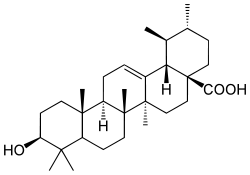Ursolic acid
 | |
| Names | |
|---|---|
| IUPAC name
(1S,2R,4aS,6aR,6aS,6bR,8aR,10S,12aR,14bS)-10-hydroxy-1,2,6a,6b,9,9,12a-heptamethyl-2,3,4,5,6,6a,7,8,8a,10,11,12,13,14b-tetradecahydro-1H-picene-4a-carboxylic acid[1] | |
| Other names
Prunol, Malol, beta-Ursolic acid, NSC4060, CCRIS 7123, TOS-BB-0966, 3-beta-hydroxyurs-12-en-28-oic acid[1] | |
| Identifiers | |
| 77-52-1 | |
| ChEBI | CHEBI:9908 |
| ChEMBL | ChEMBL169 |
| ChemSpider | 58472 |
| |
| Jmol-3D images | Image |
| PubChem | 64945 |
| |
| Properties | |
| Molecular formula |
C30H48O3 |
| Molar mass | 456.70 g·mol−1 |
| Melting point | 285 to 288 °C (545 to 550 °F; 558 to 561 K) |
| Boiling point | 556.89 °C (1,034.40 °F; 830.04 K) |
| Except where noted otherwise, data is given for materials in their standard state (at 25 °C (77 °F), 100 kPa) | |
| | |
| Infobox references | |
Ursolic acid (sometimes referred to as urson, prunol, malol, or 3-beta-3-hydroxy-urs-12-ene-28-oic-acid), is a pentacyclic triterpenoid identified in the epicuticular waxes of apples as early as 1920 and widely found in the peels of fruits, as well as in herbs and spices like rosemary and thyme.[2] It has been used in cosmetics and is also capable of inhibiting various cancer cell types by inhibiting the STAT3 activation pathway,[3][4] and may also decrease proliferation of cancer cells and induce apoptosis.[5] Ursolic acid has also been shown to inhibit JNK expression and IL-2 activation of JURKAT leukemic T Cells leading to the reduction in proliferation and T cell activation.[6]
Ursolic acid can serve as a starting material for synthesis of more potent bioactive derivatives, such as antitumor agents.[7] It has been found to reduce muscle atrophy and to stimulate muscular growth in mice,[8][9] also showing a potential for therapeutic use as a cardioprotective compound.[2][10]
Ursolic acid was found to be a weak aromatase inhibitor (IC50 = 32 μM)[11] and has been shown to increase the amount of muscle and brown fat and decrease white fat obesity and associated conditions when added to diets fed to mice.[2][12] Under physiological concentrations, ursolic acid also induces eryptosis (the apoptosis-like suicidal cell death in defective red blood cells).[13]
Natural occurrences
Ursolic acid is present in many plants, such as Mirabilis jalapa,[14] as well as in many frutis and herbs used in daily life (e.g. apples, basil, bilberries, cranberries, elder flower, peppermint, rosemary, lavender, oregano, thyme, hawthorn, and prunes). Apple peels contain large quantities of ursolic acid and related compounds.[15]
See also
References
- ↑ 1.0 1.1 PubChem 64945
- ↑ 2.0 2.1 2.2 Felizola SJA (2015). "Ursolic acid in experimental models and human subjects: potential as an anti-obesity/overweight treatment?". ResearchGate. doi:10.13140/RG.2.1.4502.4804.
- ↑ Shishodia S, Majumdar S, Banerjee S, Aggarwal BB (2003). "Ursolic acid inhibits nuclear factor-kappaB activation induced by carcinogenic agents through suppression of IkappaBalpha kinase and p65 phosphorylation: correlation with down-regulation of cyclooxygenase 2, matrix metalloproteinase 9, and cyclin D1". Cancer Res. 63 (15): 4375–83. PMID 12907607. Full-text pdf
- ↑ Pathak AK; Bhutani M; Nair AS et al. (2007). "Ursolic acid inhibits STAT3 activation pathway leading to suppression of proliferation and chemosensitization of human multiple myeloma cells". Mol. Cancer Res. 5 (9): 943–55. doi:10.1158/1541-7786.MCR-06-0348. PMID 17855663.
- ↑ Wang X, Zhang F, Yang L, Mei Y, Long H, Zhang X, Zhang J, Qimuge-Suyila , Su X.,"Ursolic acid inhibits proliferation and induces apoptosis of cancer cells in vitro and in vivo", J Biomed Biotechnol. 2011;2011:419343 Full-text pdf
- ↑ Kaewthawee, Narawan; Brimson, Sirikalaya (February 2013). "THE EFFECTS OF URSOLIC ACID ON CYTOKINE PRODUCTION VIA THE MAPK PATHWAYS IN LEUKEMIC T-CELLS" (PDF). EXCLI 12 (February): 102–114.
- ↑ Ma CM, Cai SQ, Cui JR, Wang RQ, Tu PF, Hattori M. Daneshtalab, M (2005). "The cytotoxic activity of ursolic acid derivatives". Eur. J. Med. Chem 40 (6): 582–589. doi:10.1016/j.ejmech.2005.01.001. PMID 15922841.
- ↑ Kunkel, S. D.; Suneja, M.; Ebert, S. M.; Bongers, K. S.; Fox, D. K.; Malmberg, S. E.; Alipour, F.; Shields, R. K.; Adams, C. M. (2011). "MRNA Expression Signatures of Human Skeletal Muscle Atrophy Identify a Natural Compound that Increases Muscle Mass". Cell Metabolism 13 (6): 627–638. doi:10.1016/j.cmet.2011.03.020. PMC 3120768. PMID 21641545.
- ↑ "Apple Ingredient Keeps Muscles Strong: Component of Apple Peels Found to Help Prevent Muscle Weakening in Mice". ScienceDaily, News, June 7, 2011,
- ↑ Liobikas J, Majiene D, Trumbeckaite S, Kursvietiene L, Masteikova R, Kopustinskiene DM, Savickas A, Bernatoniene J.,"Uncoupling and antioxidant effects of ursolic acid in isolated rat heart mitochondria", J Nat Prod. 2011 Jul 22;74(7):1640-4
- ↑ Gnoatto, SC; Dassonville-Klimpt, A; Da Nascimento, S; Galéra, P; Boumediene, K; Gosmann, G; Sonnet, P; Moslemi, S (2008). "Evaluation of ursolic acid isolated from Ilex paraguariensis and derivatives on aromatase inhibition". European journal of medicinal chemistry 43 (9): 1865–77. doi:10.1016/j.ejmech.2007.11.021. PMID 18192087.
- ↑ Kunkel, Steven D. (2012). "Ursolic Acid Increases Skeletal Muscle and Brown Fat and Decreases Diet-Induced Obesity, Glucose Intolerance and Fatty Liver Disease". PLoS ONE 7 (6): e39332. doi:10.1371/journal.pone.0039332.
- ↑ PMID 21923134
- ↑ Constituents of Mirabilis jalapa. Siddiqui S., Siddiqui B.S., Adil Q. and Begum S., Fitoterapia, 1990, Volume 61, No. 5, page 471 (abstract)
- ↑ MacRae, Fiona. "An apple a day keeps the doctor away... as long as you eat the peel". Daily Mail (London).